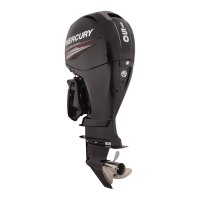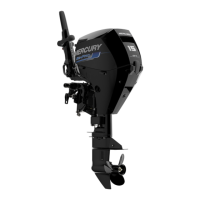3
B
EMISSIONS
90-826883R2 JUNE 1998 Page 3B-1
FUEL SYSTEM
Section 3B - Emissions
Table of Contents
Table of Contents 3C-1. . . . . . . . . . . . . . . . . . . . . . . . . . . .
Exhaust Emissions Standards 3C-1. . . . . . . . . . . . . . . . .
What Are Emissions? 3C-1. . . . . . . . . . . . . . . . . . . . . .
Hydrocarbons – HC 3C-1. . . . . . . . . . . . . . . . . . . . . . . .
Carbon Monoxide – CO 3C-1. . . . . . . . . . . . . . . . . . . .
Oxides of Nitrogen - NOx 3C-1. . . . . . . . . . . . . . . . . . .
Controlling Emissions 3C-2. . . . . . . . . . . . . . . . . . . . . .
Stoichiometric (14.7:1) Air/Fuel Ratio 3C-2. . . . . . . .
Outboard Hydrocarbon Emissions Reductions 3C-3. . .
Stratified VS Homogenized Charge 3C-4. . . . . . . . . . . . .
Homogenized Charge 3C-4. . . . . . . . . . . . . . . . . . . . . .
Stratified Charge 3C-5. . . . . . . . . . . . . . . . . . . . . . . . . .
Emissions Information 3C-5. . . . . . . . . . . . . . . . . . . . . . . .
Manufacturer’s Responsibility 3C-5. . . . . . . . . . . . . . .
Dealer Responsibility 3C-6. . . . . . . . . . . . . . . . . . . . . .
Owner Responsibility 3C-6. . . . . . . . . . . . . . . . . . . . . .
EPA Emission Regulations 3C-6. . . . . . . . . . . . . . . . .
Decal Location 3C-7. . . . . . . . . . . . . . . . . . . . . . . . . . . .
Exhaust Emissions Standards
Through the Environmental Protection Agency (EPA), the federal government has estab-
lished exhaust emissions standards for all new marine engines sold in the U.S.
What Are Emissions?
Emissions are what comes out of the exhaust system in the exhaust gas when the engine
is running. They are formed as a result of the process of combustion or incomplete com-
bustion. To understand exhaust gas emissions, remember that both air and fuel are made
of several elements. Air contains oxygen and nitrogen among other elements; gasolene
contains mainly hydrogen and carbon. These four elements combine chemically during
combustion. If combustion were complete, the mixture of air and gasoline would result in
these emissions: water, carbon dioxide and nitrogen, which are not harmful to the environ-
ment. But combustion is not usually complete. Also, potentially harmful gases can be
formed during and after combustion.
All marine engines must reduce the emission of certain pollutants, or potentially harmful
gases, in the exhaust to conform with levels legislated by the EPA. Emissions standards
become more stringent each year. Standards are set primarily with regard to three emis-
sions: hydrocarbons (HC), carbon monoxide (CO) and oxides of nitrogen (NOx).
Hydrocarbons – HC
Gasoline is a hydrocarbon fuel. The two elements of hydrogen and carbon are burned
during combustion in combination with oxygen. But they are not totally consumed. Some
pass through the combustion chamber and exit the exhaust system as unburned gases
known as hydrocarbons.
Carbon Monoxide – CO
Carbon is one of the elements that make up the fuel burned in the engine along with oxy-
gen during the combustion process. If the carbon in the gasoline could combine with
enough oxygen (one carbon atom with two oxygen atoms), it would come out of the en-
gine in the form of carbon dioxide (CO
2
). CO
2
is a harmless gas. But carbon often com-
bines with insufficient oxygen (one carbon atom with one oxygen atom). This forms car-
bon monoxide, CO. Carbon monoxide is the product of incomplete combustion and is a
dangerous, potentially lethal gas.

